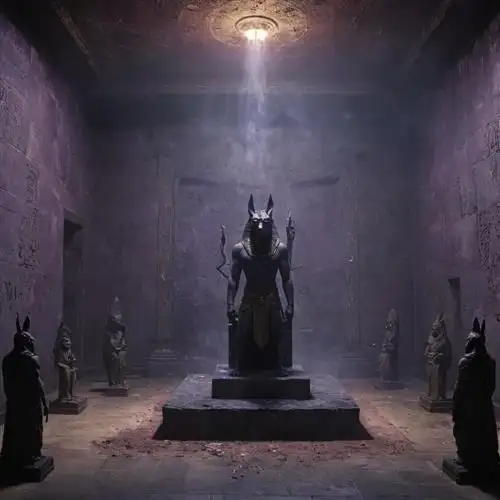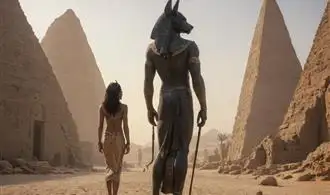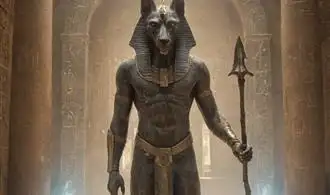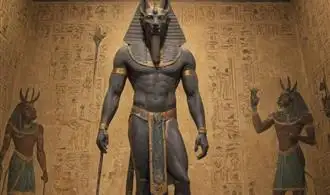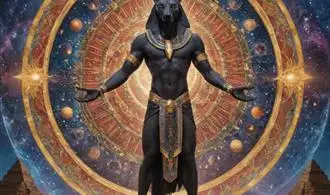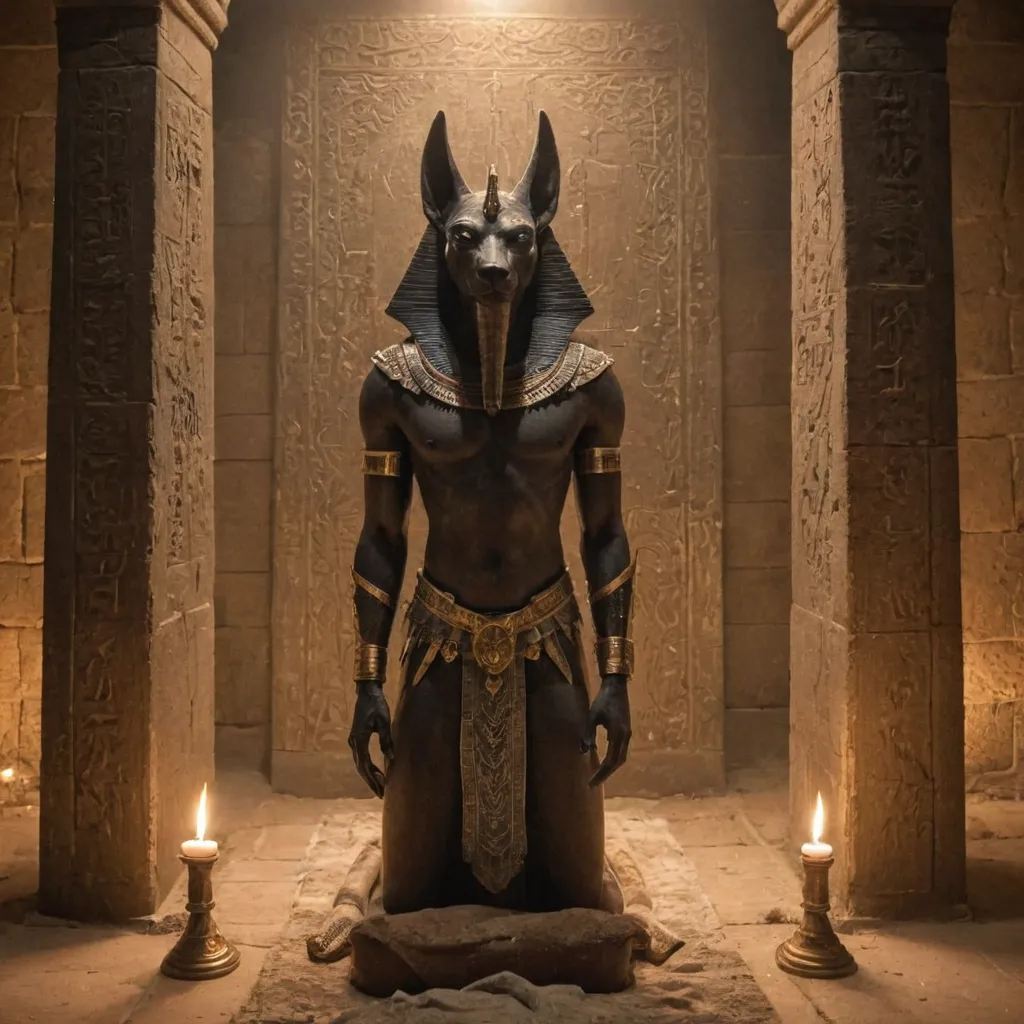
The Invocation of Anubis
The Invocation of Anubis is a powerful ritual that has been practiced for centuries, offering a profound connection to the Egyptian god of the dead and the afterlife. This ancient ritual is not merely a ceremonial gesture but a transformative experience that can deeply impact one's spiritual and emotional well-being.
At the heart of the Invocation of Anubis lies a deep reverence for the mysteries of death and the afterlife. Anubis, the jackal-headed deity, is believed to guide the souls of the departed through the underworld, ensuring a safe passage to the next realm. By aligning oneself with the energies of Anubis, practitioners can tap into a wellspring of wisdom and inner strength, gaining a deeper understanding of the cycle of life and death.
The ritual itself is a multi-layered experience, requiring a steadfast commitment and a willingness to surrender to the transformative power of the divine. It often begins with a period of introspection and meditation, allowing the practitioner to quiet the mind and attune to the subtle energies of Anubis. This may be followed by the invocation of the deity, a sacred chant or mantra that calls upon Anubis to lend his guidance and protection.
As the practitioner delves deeper into the ritual, they may engage in specific practices that align with the attributes of Anubis. For example, they may choose to perform a ritual cleansing or purification, symbolically shedding the burdens and attachments that no longer serve them. Some may also incorporate the use of sacred objects, such as statues or amulets, to deepen their connection to the divine energy of Anubis.
One of the most profound aspects of the Invocation of Anubis is its ability to facilitate transformation and personal growth. By embracing the mysteries of death and the afterlife, practitioners can gain a newfound appreciation for the fragility and fleeting nature of life. This understanding can lead to a greater sense of gratitude, a release of fear, and a deeper commitment to living a life of purpose and authenticity.
Moreover, the Invocation of Anubis is believed to offer protection and guidance in the afterlife, ensuring a seamless transition for the soul. By aligning oneself with the energy of Anubis, practitioners can find solace in the knowledge that they are not alone, but rather, they are under the watchful gaze of a powerful and benevolent deity.
The Rites of Mummification
Mummification, a central ritual in the worship of Anubis, the Egyptian god of the dead, was a complex and intricate process that transformed the deceased into an eternal being. The rites of mummification were not merely a physical process but a spiritual journey, infused with profound symbolism and meticulous attention to detail.
The mummification process typically began with the removal of the internal organs, which were placed in canopic jars and offered to the gods. The body was then carefully cleaned and dehydrated using natron, a naturally occurring salt. This step was crucial in preserving the physical form and preventing decomposition.
Next, the body was wrapped in linen bandages, a ritual that held deep significance. Each layer of fabric was imbued with prayers and incantations, transforming the wrappings into a protective shell that would safeguard the deceased during their journey to the afterlife. The wrapping process was a delicate and highly symbolic task, with the positioning of the limbs and the inclusion of specific amulets and talismans carefully orchestrated.
The final stage of mummification involved the placement of the mummy within a sarcophagus, a richly decorated coffin that served as the deceased's final resting place. The sarcophagus was often adorned with intricate carvings, hieroglyphics, and images of the gods, ensuring that the mummy was surrounded by the divine protection they would need in the afterlife.
The rites of mummification were not merely practical in nature but were imbued with deep spiritual significance. Each step of the process was infused with prayers, incantations, and ritual offerings, transforming the physical act into a sacred journey. The mummy, in essence, became a vessel for the soul, a physical manifestation of the individual's transition into the afterlife.
The Weighing of the Heart
The Weighing of the Heart is a profound ritual within the Anubis tradition, holding immense significance for those seeking spiritual transformation. This ritual, rooted in ancient Egyptian mythology, is a symbolic journey of self-reflection and purification, where the individual's soul is weighed against the feather of truth.
At the heart of this ritual lies the belief that the deceased must undergo a judgment before they can enter the afterlife. Anubis, the jackal-headed god of the dead, presides over this process, ensuring the integrity of the weighing. The individual's heart is placed on one side of a scale, while the feather of truth, representing the goddess Ma'at, rests on the other.
If the heart is found to be pure, balanced, and in harmony with the principles of Ma'at (truth, justice, and righteousness), the individual is granted passage to the afterlife. However, if the heart is deemed heavier, weighted down by the burden of misdeeds, the individual is denied entry and, in some versions of the myth, is subjected to a gruesome demise.
For the living, the Weighing of the Heart ritual serves as a powerful metaphor for self-examination and personal growth. By engaging in this ritual, individuals are encouraged to confront their own flaws, fears, and biases, and to strive for a state of inner balance and alignment with the divine principles of truth and justice.
The ritual typically involves a series of meditations, prayers, and symbolic gestures, all designed to help the individual connect with the energy of Anubis and the process of the Weighing of the Heart. Some key elements of this ritual may include:
- Invoking the presence of Anubis and the deities associated with the ritual
- Engaging in deep self-reflection, honest assessment of one's actions and motivations
- Releasing any negative emotions, guilt, or attachments that may weigh down the heart
- Visualizing the heart and the feather of truth on the scale, and the process of the weighing
- Affirming one's commitment to living in alignment with the principles of Ma'at
Anubis and the Guardian of the Dead
Anubis, the ancient Egyptian god of the dead, has long been revered for his role as the guardian of the underworld. As the protector of the deceased, Anubis played a crucial part in the journey of the soul from this life to the next. Understanding the rituals and practices associated with Anubis can offer profound insights into the mysteries of death and the afterlife, transforming our perspectives on life itself.
At the heart of Anubis' role as the guardian of the dead lies his responsibility for the mummification process. As the god responsible for embalming and preparing the deceased for their journey into the afterlife, Anubis ensured that the physical body was properly preserved, allowing the soul to maintain its connection to the mortal realm. The meticulous attention to detail and reverence with which Anubis approached this task speaks to the profound respect and importance placed on the transition from life to death in ancient Egyptian belief systems.
Beyond his role in the mummification process, Anubis was also responsible for guiding the deceased through the trials and tribulations of the afterlife. In the underworld, Anubis would assist the dead in navigating the complex and often treacherous landscape, ensuring their safe passage to the realm of the gods. This guidance was essential, as the ancient Egyptians believed that the afterlife was a realm fraught with challenges and obstacles that the deceased would need to overcome to achieve eternal peace and communion with the divine.
Rituals and practices associated with Anubis often focused on invoking his protection and guidance. One such ritual, known as the "Opening of the Mouth Ceremony," was an integral part of the mummification process. During this ritual, the mouth of the deceased was "opened" through a series of gestures and incantations, allowing the soul to speak and interact with the gods of the underworld. This powerful ritual was believed to facilitate the deceased's transition into the afterlife, ensuring their ability to communicate and engage with the divine entities they would encounter.
Another significant ritual associated with Anubis was the "Weighing of the Heart" ceremony. In this ritual, the deceased's heart was weighed against the feather of Ma'at, the goddess of truth and justice. If the heart was found to be pure and free of sin, the soul was granted passage to the afterlife. This ceremony was a testament to the importance of moral and ethical conduct in the ancient Egyptian worldview, with Anubis serving as the guardian and arbiter of this critical judgment.
The Rites of Passage to the Afterlife
The Rites of Passage to the Afterlife are a crucial aspect of Anubis worship, as this Egyptian deity is closely associated with the process of death, mummification, and the journey to the afterlife. These rituals hold profound significance, offering a pathway for the deceased to transition into the next realm and ensuring their safe passage through the challenges they may face.
At the heart of these rites lies the critical role of Anubis, the jackal-headed god who presides over the mummification process and guides the dead through the perilous underworld. The rituals involve a meticulous and sacred set of practices, each with its own symbolic meaning and purpose.
One of the most important rites is the Opening of the Mouth ceremony, where the deceased's mouth is "opened" to allow them to breathe, speak, and partake of offerings in the afterlife. This ritual is believed to restore the individual's senses and faculties, empowering them to navigate the challenges of the afterlife. Another pivotal rite is the Weighing of the Heart, where the deceased's heart is weighed against the feather of truth, determining their worthiness to enter the afterlife.
Alongside these rituals, the mummification process itself holds profound significance. The careful preservation of the body, the removal of the internal organs, and the wrapping in sacred bandages all serve to prepare the deceased for their journey to the afterlife. These practices are not merely practical; they are imbued with deep spiritual meaning, connecting the physical form to the metaphysical realm.
The Rites of Passage to the Afterlife are not limited to the deceased; they also involve the living, who play a crucial role in ensuring the safe passage of their loved ones. Mourning rituals, funerary processions, and the placement of offerings and amulets within the tomb all contribute to the overall process of honoring the dead and facilitating their transition to the next life.

